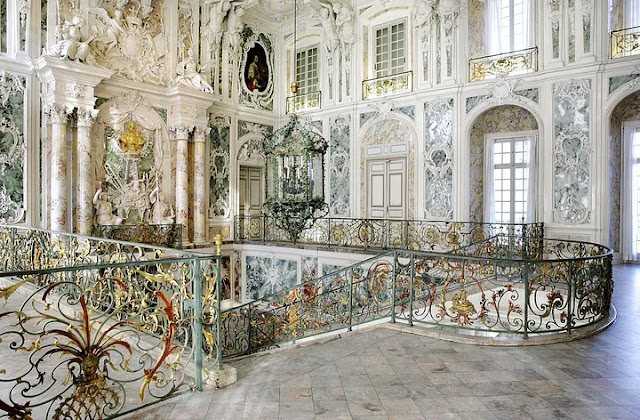How to recognize the Rococo architecture? A visual guide through the main characteristics
 |
| A great example of the Rococo architecture in Germany — a flamboyant staircase in the Schloss Augustusburg in Cologne. |
After the majestic and dramatic Baroque period in architecture and art, the artists who were proponents of the Rococo style brought features that distinguished this style from every movement before that. Rococo was a more light, playful, and uplifting style compared to all its forefathers. What features make this style stand out? Our visual guide will give you the answers and examples.
Asymmetrical ornaments
The complexity of the Rococo stucco and carvings was also mixed with the asymmetry. The more flamboyant the ornaments looked, the better. There were no strict guidelines for the Rococo artists, and the lack of symmetry only gave more opportunities to create the most complex and incredible decorations for the buildings. It was a peak of artistic freedom that helped to create some of the most impressive architectural buildings in the world.
Cartouches
The decorations of the Rococo facades and interiors brought a great variety of complex ornaments that featured cartouches. Visually, a cartouche reminds a shield that can also feature a heraldic symbol, a pattern of geometrical figures, or even a little statue. It’s mostly surrounded by a very beautiful and complex set of carvings. Cartouches are one of the key elements that make Rococo architecture stand out.
Size of a building
Often, Rococo buildings were small in size. Especially, those that were built as complementary pieces to palaces. However, the humble size of a building was always compensated by rich and diverse interior decorations. In Germany, there is Linderhof Palace. It was commissioned by the Bavarian King Ludwig II in the 19th century. The palace was built after the Rococo period, but Ludwig II ordered the architect to make it in the best traditions of the Rococo style. It’s a small palace with a flamboyant, colorful interior.
Pastel tones
One of the common features of the Rococo buildings (and paintings) was the variety of warm pastel tones. Whether those were the massive facades or smaller elements, such as interior details, those usually were painted in blue, pink, pastel green, and yellow colors.
Rocaille
The term Rococo is derived from the French word Rocaille. It was an element that resembled seashells and waves. Since the Rococo artists loved the attention to detail, the numerous carvings and stucco’s on the facades, ceilings, and interiors of the Rococo buildings featured curvy forms that looked like seashells.
Oriental motifs
The exteriors and interiors of the Rococo buildings displayed some influences of Oriental motifs. In particular, from the Chinese and Japanese cultures. Architects of the Rococo period tried to diversify European design and implement some foreign elements in the ornaments of the buildings. It added some exotic flavor to these architectural structures. It was not unusual to see the elements from Chinese pagodas, embodied somewhere in the garden buildings in Germany or France during the 18th century.
Of course, many of the Rococo’s characteristics were based on the Baroque stylistics, and some saw this movement as a version of upgraded Baroque. However, the architects and the craftsmen around Europe had different influences and visions that helped to add diversity to Rococo. If we simplify — the French Rococo was not the same as the German Rococo or Spanish Rococo. Local cultural code impacted the look and choice of the ornaments and interior details of the buildings. Still, architects were united by the idea of presenting the most flamboyant outcome possible, funded by wealthy monarchs and the bourgeois.
For more history content, subscribe to our YouTube channel!






Comments
Post a Comment